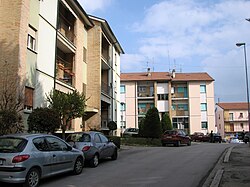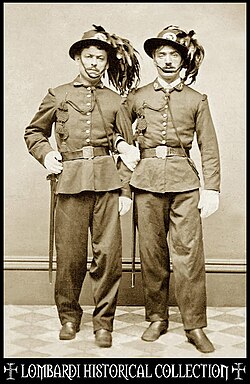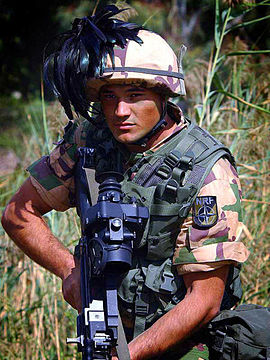This is an old revision of this page, as edited by Solarinoridge (talk | contribs) at 07:03, 31 May 2008. The present address (URL) is a permanent link to this revision, which may differ significantly from the current revision.
Revision as of 07:03, 31 May 2008 by Solarinoridge (talk | contribs)(diff) ← Previous revision | Latest revision (diff) | Newer revision → (diff)
The Bersaglieri (
- REDIRECT Template:IPA-all) are a corps of the Italian Army created by General Alessandro La Marmora in 1836 to serve in the Piedmontese Army, later to become the Royal Italian army. The name "Bersaglieri" means "sharpshooters". They have always been a high-mobility infantry unit, and can still be recognized by the distinctive wide brimmed hat that they wear (only in dress uniform in modern times), decorated with capercaillie feathers. The feathers are typically applied even to modern combat helmets.
Origins and history
The relatively poor Kingdom of Savoy could not afford large numbers of cavalry, so a quick-moving infantry corps of marksmen was needed. These troops were trained to high physical and marksmanship standards. Like the French chasseurs who inspired their creation, a level of independence and initiative was encouraged so that they could operate in looser formations where direct command and control was not required. They fired individually and carried 60 rounds instead of the standard 40 rounds of traditional line infantry. The first uniform was black with brimmed hats, called "vaira". These were intended to defend the head from sabre blows.
The first public appearance of the Bersaglieri was on the occasion of a military parade on July 1, 1836. The First Company marched through Turin with the rapid, high-stepping gait (130 paces/minute) still used by the Bersaglieri in World War II and later. The modern Bersaglieri still run both on parade and even during barracks duty - on penalty of punishment if they do not. The new corps impressed King Carlo Alberto, who immediately had them integrated as part of the "Armata Sarda" - the Piedmontese regular army.
Throughout the nineteenth century, under La Marmora’s leadership, the Bersaglieri filled the role of skirmishers, screening the slow-moving line and column formations, but acting as special shock troops if required. They were originally intended to serve as mountain troops, as well; the climber Jean Antoine Carrel was a Bersagliere. When the Alpini Corps were created in 1872 a strong rivalry arose between the two elite corps.
Unified Italy

During the First War of Italian Independence (1848-1849) the Bersaglieri distinguished themselves by storming the bridge at Goito. The most famous action of the Bersaglieri occurred on 20 September 1870, when they entered Rome through the Porta Pia, ending the temporal power of the Pope, and completing the unification of Italy.
The Bersaglieri were deployed abroad for the first time during the Crimean War, by order of Prime Minister Camillo Benso. They were involved in the Battle of the Cernaia, but suffered more casualties due to a cholera epidemic. While in the Crimea the Bersaglieri acquired their undress headdress - a purple/red fez with a blue tassel in imitation of that worn by the French zouaves with whom they served.
When the Armata Sarda became the Regio Esercito (Royal Italian Army) in 1860, the number of Bersaglieri regiments was set at 12. The Bersaglieri served as the light infantry battalions of the brigades and divisions of the new army of united Italy. Army doctrine later in the century called for them to be held back as corps-level reserves.
World War I

During the First World War, the 12 regiments of Bersaglieri fought with distinction. Of 210,000 members of Bersaglieri regiments 32,000 were killed and 50,000 wounded during the war. After the War, restructuring of the Italian Army reduced the number of Bersaglieri battalions to two per regiment. A new role was seen for the light infantry as part of Italy’s commitment to mobile warfare.
The post-war Bersaglieri were converted into bicycle troops to fight alongside cavalry in the Celeri (fast) divisions. Elite units with high morale and an aggressive spirit were seen as one way to break such tactical stalemates as the trench warfare of 1915-18. The Bersaglieri gave Italy highly trained formations suitable for service with both cavalry and tanks. When the armoured divisions were formed in 1939 the link between the Bersaglieri and mobile warfare continued. Each new armoured and motorised division was allocated one Bersaglieri regiment.
World War II
Italy’s Bersaglieri regiments were expanded to three battalions each during the Second World War. However, the Army resisted any temptation to dilute their quality, and recruits continued to be of above-average size and stamina. They endured intense physical training, just as their great-grandfathers had, as well as having to qualify as marksmen.
The Bersaglieri fought in southern France and Greece in 1940. The first Bersaglieri to see combat in North Africa was the 10th Bersaglieri Regiment. They arrived in Libya in early 1941. The Regiment met disaster before reaching the front, when British tanks ambushed its truck convoys well inside what the regimental staff had been told was the secure rear area. The Italian "sharpshooters" exacted retribution on 8 April 1941 when the 'Ariete' Armoured Division's 8th Bersaglieri Regiment surrounded and captured 2,700 British, Indian and Australian troops fleeing from Mechili. The 8th Bersaglieri Regiment also played an important part in the defeat of British armour at El Gubi in November 1942. The 7th Bersaglieri Regiment also met with success when two battalions took 6,500 prisoners in the fighting for Mersa Matruh on 28 June 1942. During the fighting for Ruweisat Ridge the 9th Bersaglieri Regiment along with the "Trieste" Infantry Division showed great courage. "The German soldier has impressed the world, General Erwin Rommel wrote in a plaque dedicated to the Bersaglieri that fought at Alamein . "However the Italian Bersaglieri soldier has impressed the German soldier .
The Bersaglieri remained a force to be reckoned with even after the defeat at Alamein and, on 3 December 1942 a battalion pursued and forced the surrender of 300 British soldiers of the 2nd Battalion the Parachute Regiment. (However, the embarrased British reported that they had been in contact with 5th FJR Afrika (5th Fallschirmjager Regiment Africa) supported by tanks and heavy armoured cars).The Bersaglieri soldier proved its indomitable fighting spirit yet again, during the Battle of the Kasserine Pass and a battalion along with the Italian "Centauro" Armoured Division captured 3,500 American soldiers.
In all, six of the 12 regiments fought in North Africa, compiling an excellent combat record and in the Allied invasion of Sicily the 35th and 73rd Bersaglieri Battalion managed to hold off the American advance on the Castrofilippo-Napo and the Naro River area but were eventually overwhelmed by sheer weight of fire.

Bersaglieri today

While in the past the mobility of the Bersaglieri was helped by their training in running and by the aid of bicycles, the modern Corps are mostly mechanised.
The modern Bersaglieri have served, as part of the 'Garibaldi' Mechanised Brigade, as peacekeepers in the Multinational Force in Lebanon, and in Yugoslav and Somali Civil Wars, and were also active in Operation Iraqi Freedom. Bersaglieri traditions are still stressed. The Bersaglieri collar patches are purple-red "flames". Enlisted troops still wear the red fez. Officers wear black berets with their ordinary uniforms, but the feathered "vaira" in ceremonial uniform. They also wear black gloves, while other Italian regiments wear white ones. Each Bersaglieri unit had a band called a "fanfara", who played their instruments at the run while on parade. Today only the Garibaldi Brigade and 7th Bersaglieri regiment retain a "fanfara".
Regiments today
 1° Rgt. Bersaglieri, Garibaldi Brigade, in Cosenza (Calabria)
1° Rgt. Bersaglieri, Garibaldi Brigade, in Cosenza (Calabria) 3° Rgt. Bersaglieri, Ariete Brigade, in Milan (Lombardy)
3° Rgt. Bersaglieri, Ariete Brigade, in Milan (Lombardy) 6° Rgt. Bersaglieri, Aosta Brigade, in Trapani (Sicily)
6° Rgt. Bersaglieri, Aosta Brigade, in Trapani (Sicily) 7° Rgt. Bersaglieri, Pinerolo Brigade, in Bari (Apulia)
7° Rgt. Bersaglieri, Pinerolo Brigade, in Bari (Apulia) 8° Rgt. Bersaglieri, Garibaldi Brigade, in Caserta (Campania)
8° Rgt. Bersaglieri, Garibaldi Brigade, in Caserta (Campania) 11° Rgt. Bersaglieri, Ariete Brigade, in Orcenico Superiore (Friuli-Venezia Giulia)
11° Rgt. Bersaglieri, Ariete Brigade, in Orcenico Superiore (Friuli-Venezia Giulia)